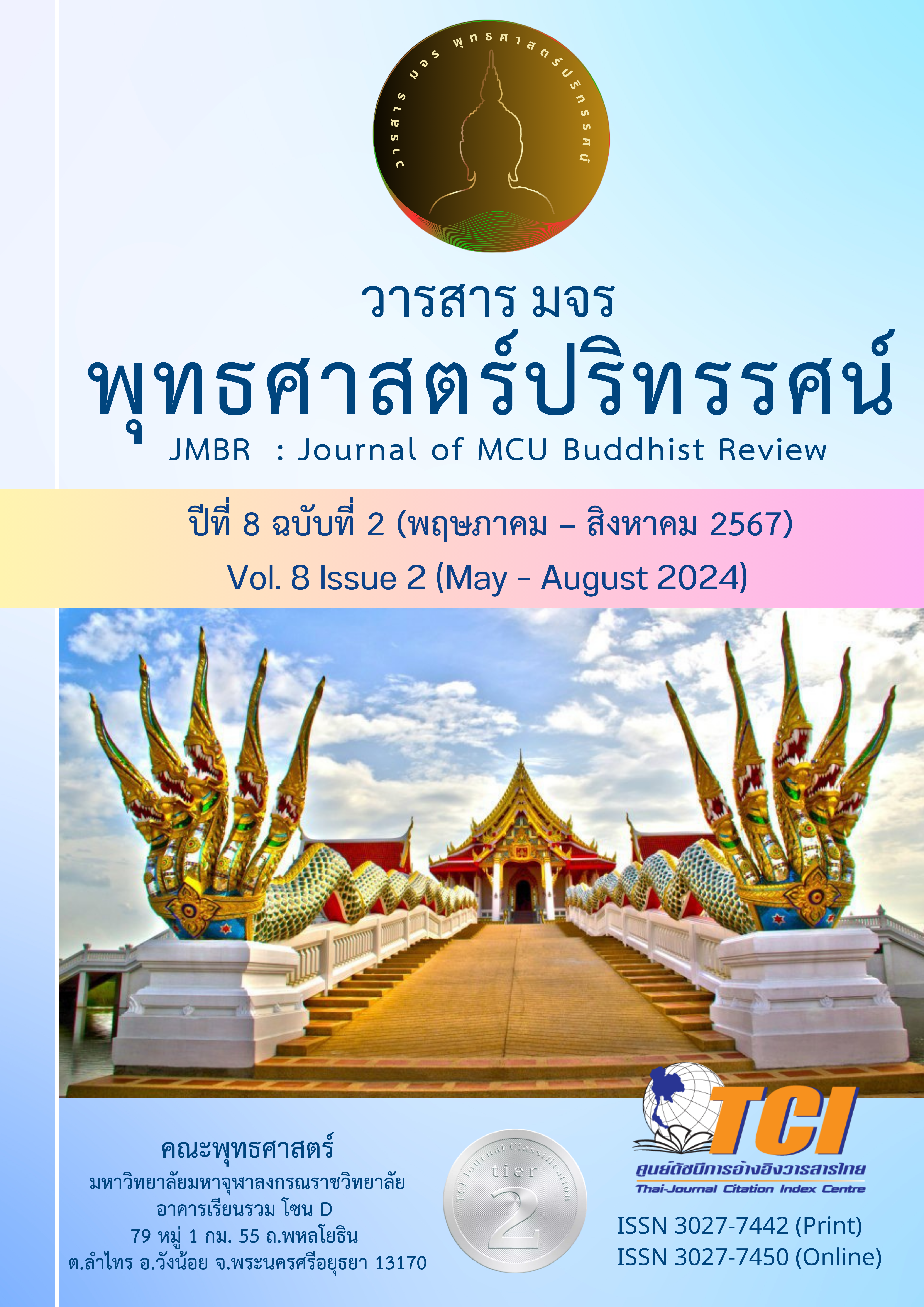วิเคราะห์พุทธวิธีการตอบปัญหาของท้าวสักกะในสักกปัญหสูตร
Main Article Content
บทคัดย่อ
บทความวิจัยนี้มีวัตถุประสงค์ 1) เพื่อศึกษาโครงสร้างและสาระสำคัญในสักกปัญหสูตร 2) เพื่อศึกษาพุทธวิธีการตอบปัญหาของพระพุทธเจ้าในคัมภีร์พระพุทธศาสนาเถรวาท 3) เพื่อศึกษาวิเคราะห์พุทธวิธีการตอบปัญหาของท้าวสักกะในสักกปัญหสูตร เป็นงานวิจัยเชิงเอกสารโดยการศึกษาข้อมูลจากคัมภีร์พระพุทธศาสนาเถรวาทและเอกสารต่าง ๆ ที่เกี่ยวข้อง พร้อมทั้งสรุป วิเคราะห์ เรียบเรียง และบรรยายเชิงพรรณนา
ผลการวิจัยพบว่า 1) สักกปัญหสูตร เป็นพระสูตรว่าด้วยปัญหาของท้าวสักกะที่ทูลถามพระพุทธเจ้า เป็นบรรยายโวหารแบบถาม-ตอบมี 2 ภาณวาร ภาณวารที่ 1 เป็นตอนปัญจสิขะคันธรรพบุตรบรรเลงเพลงและตอนท้าวสักกะเข้าเฝ้า และภาณวารที่ 2 เป็นตอนที่ท้าวสักกะทูลถามปัญหาและตอนที่พระผู้มีพระภาคตรัสถามท้าวสักกะ 2) พุทธวิธีการตอบปัญหาแบ่งเป็น 4 ประการได้แก่ (1) ปัญหาที่ตอบแบบตรงไปตรงมา (2) ปัญหาที่ย้อนถามให้ชัดเจนก่อนแล้วจึงตอบปัญหานั้น (3) ปัญหาที่ควรแยกตอบเป็นประเด็น (4) ปัญหาที่ไม่ควรตอบเพราะไม่มีประโยชน์ ส่วนลีลาการสอนของพระพุทธเจ้าคือทรงมีจุดมุ่งหมาย วิธีการ อุบาย รูปแบบ แผนการสอน การสื่อสารในการสอน ซึ่งการสอนนับเป็นพุทธกิจที่สำคัญอีกด้วย 3) พุทธวิธีการตอบปัญหาในสักกปัญหสูตร คือ เพราะทรงทราบเรื่องการปฏิบัติธรรมและผลแห่งการปฏิบัติธรรมของโคปกเทพบุตร พระองค์จึงทรงอนุญาตให้ทูลถามปัญหา ผลของการฟังพยากรณ์ปัญหาในครั้งนั้นทำให้ท้าวสักกะและเทวดาผู้เป็นบริวาร 80,000 ตน ได้ดวงตาเห็นธรรม บรรลุเป็นพระโสดาบัน และละความเป็นท้าวสักกะแก่ถึงความเป็นท้าวสักกะหนุ่ม
Article Details

อนุญาตภายใต้เงื่อนไข Creative Commons Attribution-NonCommercial-NoDerivatives 4.0 International License.
- บทความที่ได้รับการตีพิมพ์เป็นลิขสิทธิ์ของวารสาร มจร พุทธศาสตร์ปริทรรศน์
- ข้อความใดๆ ที่ปรากฎในบทความที่ได้รับการตีพิมพ์ในวารสาร ถือเป็นความรับผิดชอบของผู้เขียนบทความ และข้อคิดเห็นนั้นไม่ถือว่าเป็นทัศนะและความรับผิดชอบของกองบรรณาธิการวารสาร มจร พุทธศาสตร์ปริทรรศน์
เอกสารอ้างอิง
กิตติธัช ศรีฟ้า. (2561). พระอินทร์ในบริบทสังคมไทย. วารสารศิลป์พีระศรี. 6(1), 68-72.
บวรนรรฏ อัญญะโพธิ์ และอนุกูล โรจนสุขสมบูรณ์. (2565). พระอินทร์ในนาฏกรรมไทย. วารสารศิลปกรรมศาสตร์ มหาวิทยาลัยขอนแก่น. 14(1), 183-202.
พระครูพิมลธรรมานุกูล (สันติชัย โชติโก). (2561). การวิเคราะห์หลักพุทธธรรมที่ปรากฏในสักกปัญหสูตร. วิทยานิพนธ์หลักสูตรพุทธศาสตรมหาบัณฑิต บัณฑิตวิทยาลัย: มหาวิทยาลัยมหาจุฬาลงกรณราชวิทยาลัย.
พระอธิการวิชาญ ปิยธมฺโม (พันเกษราช). (2564). การศึกษาวิเคราะห์พุทธวิธีการตอบปัญหาของพระพุทธเจ้าที่ปรากฏในอภยราชกุมารสูตร. วิทยานิพนธ์หลักสูตรพุทธศาสตรมหาบัณฑิต บัณฑิตวิทยาลัย: มหาวิทยาลัยมหาจุฬาลงกรณราชวิทยาลัย.
มนตรี สิระโรจนานันท์. (2561). พระอินทร์ในคัมภีร์พระพุทธศาสนาเถรวาท. วารสารมหาจุฬาวิชาการ. 5(1), 44-56.
มหาจุฬาลงกรณราชวิทยาลัย. (2539). พระไตรปิฎกฉบับภาษาไทย ฉบับมหาจุฬาลงกรณราชวิทยาลัย. กรุงเทพฯ: มหาจุฬาลงกรณราชวิทยาลัย.
มหาจุฬาลงกรณราชวิทยาลัย. (2556). อรรถกถาฉบับภาษาไทย ฉบับมหาจุฬาลงกรณราชวิทยาลัย. กรุงเทพฯ: มหาจุฬาลงกรณราชวิทยาลัย.
สมคิด สวยล้ำ. (2554). การศึกษาวิเคราะห์หลักธรรมจากการตอบปัญหาเทวดาของพระพุทธเจ้า. วิทยานิพนธ์หลักสูตรพุทธศาสตรมหาบัณฑิต บัณฑิตวิทยาลัย: มหาวิทยาลัยมหาจุฬาลงกรณราชวิทยาลัย.
สมเด็จพระพุทธโฆสาจารย์ (ป.อ.ปยุตฺโต). (2562). พจนานุกรมพุทธศาสน์ ฉบับประมวลศัพท์. พิมพ์ครั้งที่ 28. กรุงเทพฯ: ผลิธัมม์.
สุโขทัยธรรมาธิราช. (2540). เอกสารการสอนชุดวิชาภาคเพื่อการสื่อสาร (Language for Communication). พิมพ์ครั้งที่ 14. กรุงเทพฯ: สุโขทัยธรรมาธิราช.


